Balancing work, family, and the fast pace of life in the Chicago area can make it hard to find time for outdoor projects—yet having a personal outdoor oasis has never been more important. Planning, designing, and maintaining a landscape you love can feel overwhelming, especially with so many ideas online that don’t always suit the local climate or architecture. Conflicting advice about plant choices and hardscaping materials only adds to the frustration.
Without a focused plan tailored to your space and lifestyle, your outdoor area may feel disjointed and fall short of your vision, costing time and money on solutions that don’t last. But with the right guidance, you can create an inviting and functional landscape that truly enhances your home.
This expert-backed guide, grounded in over 65 years of experience designing and maintaining beautiful landscapes in the Chicago area, walks you through everything you need to know—from layout and plant selection to hardscape design and seasonal considerations. It’s your step-by-step roadmap to creating a space that reflects your style, supports your lifestyle, and brings you lasting joy.
The Art and Science of Landscape Design in the Chicago Area
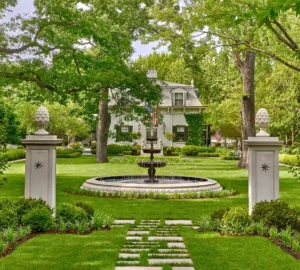
Successful landscape design in Chicago requires a unique blend of artistic vision and scientific methodology. Creating spaces that are not only visually appealing but also sustainable takes an understanding of aesthetics, horticulture, and even environmental science. The art is all about creating harmony and balance in the design, while the science involves choosing the right plants and materials for the property based on the realities of our climate.
Personal Style and Harmony
Your landscape should be an extension of your personal style and the style of your home. Whether you prefer a modern, minimalist look or a lush, traditional garden, landscape design should integrate seamlessly with your home’s architecture. Consider the colors, textures, and materials used in your home and bring those into your design.
You can use landscape design to draw attention to your home’s best features. For example, you may want to frame beautiful windows with taller evergreens, or echo the color palette of your entryway in your front yard garden beds. You will also want to pay attention to the proportion and scale of your home and extend that to your outdoor space. For example, if you have a contemporary ranch-style home, you will want to plant shorter varieties of trees and shrubs on the property to complement the architecture. If your home is several stories, the trees and shrubs you choose should be taller. This structural balance will help make your property beautiful in all seasons.
Functional and Aesthetic Balance
A successful landscape design in Chicago marries functionality with aesthetics. While it’s important that your outdoor space looks beautiful, it must also serve the needs of your household. We have found that carefully planning different ‘zones’ is essential to making sure your family’s needs are met. This ensures that no zone is an afterthought and that each zone will be not only attractive, but functional.
Key Elements of Residential Landscape Design in the Chicago Area
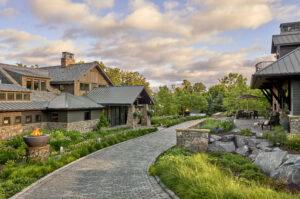
Planning and Layout
As mentioned above, the first step in planning your landscape is understanding how you intend to use the space. Do you need areas for children to play? An outdoor kitchen for entertaining? Low maintenance gardens and cozy spaces to relax with a good book? Divide your yard into the functional zones and think about how they will interact. Each zone should be designed with its purpose in mind, using furniture, plants, and structures that enhance its functionality. In a well planned landscape, these zones also interact and connect, creating a natural flow throughout your property. We like to use pathways to connect zones and use strategically placed plants to provide privacy and define boundaries.
Pathway Design and Placement
Pathways are essential for guiding movement through your landscape. They can be constructed from stone, brick, gravel or even mulch, each offering different looks and functional qualities. Echoing the materials in your home, like stone and brick, is a great way to ground the design and better highlight your home.
Consider the placement of pathways to ensure easy access to different areas. You can also use them to create visual interest and define boundaries. If you or your loved ones have mobility issues, be sure to choose materials that will help them get around with confidence. You may want to limit the use of stairs, or use smoother materials that are more friendly to wheels.
Privacy and Boundaries
Privacy is a crucial consideration in landscape design, especially in urban environments like Chicago. Use plants, screens, or fences to create secluded areas within and around your landscape. They also add beauty and layers of interest to your design.
Plant Selection and Arrangement
Choosing the right plants is important. Chicago’s climate demands hardy species that can withstand cold winters and hot summers. Native plants are often a great choice as they are adapted to local conditions and require less maintenance. Think about color, texture, and seasonal interest when selecting plants to ensure your garden is visually appealing year-round.
Native vs. Non-Invasive Plants
Native plants are well-suited to the local climate and soil conditions, making them a popular and sustainable choice. They typically require less water and maintenance, in addition to being better for our ecosystems. That said, incorporating a few non-native plants can add unique color and textures to your garden for contrast and interest.
Seasonal Interest and Color
Select plants that offer year-round interest by considering their seasonal changes in color, texture, and form. Spring blossoms, summer foliage, autumnal hues, and winter structures can each add distinct beauty to your garden. A well-planned selection will ensure that your landscape remains vibrant throughout the year.
Plant Arrangement and Layering
The arrangement of plants is critical to achieving a harmonious look. Use the concept of layering—placing taller plants at the back and shorter ones at the front—to create depth and visual interest. Consider each plant’s growth habits so they have room to mature without overcrowding. Your plantings are installed with the expectation that the garden will sleep in the first year, creep with slow growth in the second, and leap—filling in quickly—by the third. You may not get the density you want in year one, but this approach helps ensure the plants thrive as the landscape fills in.
Incorporating Hardscapes
Hardscapes such as patios, walkways, and retaining walls add structure and functionality to your landscape. Materials like stone, brick, and wood can be used to create beautiful, durable features that enhance your outdoor space. Consider incorporating outdoor lighting to highlight these features and make your outdoor space inviting well into the evening.
Choosing Hardscape Materials
Selecting the right materials for your hardscape elements is key for both aesthetics and durability. Stone, brick, and wood each offer different textures and colors, allowing you to customize the look of your space. As mentioned above, you may want to think about echoing the materials in your home when selecting materials. You will also need to consider the climate and maintenance requirements of your property when choosing materials in order to ensure your hardscapes remain beautiful and functional over time.
Integrating Hardscapes with Softscapes
Harmoniously blending hardscape elements with plantings (softscapes) creates a balanced and inviting environment. Use hardscapes to provide structure and definition, while choosing plants to add life and color. For example, a stone patio can be softened with border plantings, and a wooden pergola can be made even more beautiful with climbing vines.
Lighting and Safety
Incorporating lighting into your hardscape design extends the usability of your outdoor space into the evening and enhances safety. Use a combination of pathway lights, spotlights, and ambient lighting to highlight building features and create a warm, inviting atmosphere. Proper lighting is beautiful and makes properties safer to navigate.
Front Yard Landscaping in the Chicago Area: Making a Great First Impression
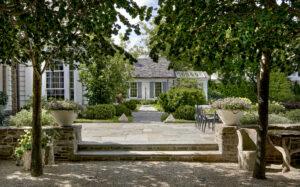
Your front yard is the first thing people see when they visit your home, and the first thing you see after a hard day of work. A well-designed front yard can enhance curb appeal and create a welcoming atmosphere your whole family loves coming home to.
Designing Your Front Yard
Focus on symmetry and balance to create a harmonious look. Use plants and hardscape details to frame the entrance to your home. Don’t forget about the driveway and pathways—these should be functional and contribute to the overall aesthetic. We also love how nicely designed planters can change with the seasons. They add a burst of beauty when you walk in the door.
Framing the Entrance
The entrance to your home sets the tone for your entire property. A cohesive planting design across the foundation and around the front walk, whether symmetrical or organic, creates a welcoming frame around the entryway, guiding visitors towards the door. Decorative planters with seasonal annuals can offer additional excitement and interest to your home.
Creating Focal Points
Focal points draw the eye and add interest to your front yard landscaping in Chicago all year long. This could be a striking tree, a sculpture, or a water feature. Position focal points strategically to enhance the overall design and make your home more inviting.
Driveway and Pathway Design
Driveways and pathways are essential elements of your front yard. Ensure they are both practical and aesthetically pleasing by using materials that will hold up throughout the seasons and complement the architecture of your home. Consider the width and layout you need for your driveway in order to accommodate circulating vehicles, parking needs, and foot traffic. A hierarchy of pathway widths and materials can help guide guests to different garden areas and add interest to your landscape. Whatever you choose should be a balanced element of the overall design.
Backyard Design Ideas for Chicago Homes
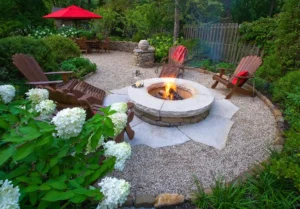
The backyard is where we relax and unwind with our nearest and dearest. When designing spaces that offer privacy, tranquility, and fun, here are some ideas to consider:
Creating a Relaxation Zone
Sometimes we get so focused on ensuring the kids have somewhere to play and we have somewhere to entertain, that we forget to carve out space just for relaxing. Designate an area with comfortable seating and maybe even a fire pit or water feature. A pergola or gazebo can provide shade and shelter, making the space functional in different weather conditions.
Comfortable Seating Options
Speaking of relaxing, we always suggest that our customers invest in high-quality outdoor furniture that invites relaxation and is built to last in Chicago. Consider options like lounge chairs, hammocks, or outdoor sofas. Arrange seating to encourage conversation and relaxation, providing a peaceful retreat from the hustle and bustle of daily life.
Fire Pits and Water Features
Adding a fire pit or water feature can enhance the ambiance of your relaxation zone. A fire pit offers warmth and provides a focal point for evening gatherings. A water feature adds a soothing, natural element. Choose designs that complement the overall aesthetic and provide year-round enjoyment.
Shelter and Shade Structures
Incorporate structures like pergolas, gazebos, or awnings to provide shelter and shade. These elements make your outdoor space more versatile, protecting against sun and rain, and allowing you to enjoy the outdoors in all weather. Enhance these structures with lighting, heaters, speakers, climbing plants, or curtains for added privacy, beauty, and functionality.
Outdoor Dining and Entertainment
If you love entertaining, consider an outdoor kitchen or dining area. Built-in grills, dining tables, and ambient lighting can transform your backyard into the perfect spot to host gatherings.
Designing an Outdoor Kitchen
An outdoor kitchen can be a fantastic addition for those who love to cook and entertain. If this is you, makes sure you include essentials like a grill, countertop space, and storage. You may also want to consider adding extras like a sink, fridge, or even a pizza oven for a fully functional outdoor cooking experience.
Dining Area Layout
Create a comfortable dining area with a sturdy table and chairs that can withstand the elements. Position the dining area close to the kitchen for convenience, and use lighting and decor to create an inviting atmosphere. Consider retractable awnings or umbrellas for shade during sunny days.
Lighting for Evening Gatherings
Lighting is key to extending the usability of your dining and entertainment spaces into the evening. Use string lights, lanterns, or built-in fixtures to create a warm, welcoming glow. Lighting not only enhances safety but also adds to the ambiance, making your backyard a perfect venue for evening gatherings.
Kid-Friendly Features
For families, incorporating a play area for children can be a great addition. Soft surfaces, swings, and even a small garden patch where kids can learn about plants and nature can make your backyard more fun. You need to be extra careful to ensure the plants you choose for these areas are safe for pets and little ones.
Designing Safe Play Areas
Safety is paramount when designing play areas for children. Beyond choosing non-toxic plants, use soft surfaces such as grass or rubber mulch to define play areas. For areas with playset equipment, cushioned play surfaces are another option to consider. Ensure that play equipment like swings or slides is age-appropriate, securely anchored, and has proper clearances from surrounding structures to prevent accidents.
Interactive and Educational Elements
Incorporate elements that inspire creativity and encourage children to explore and learn. For example, a small garden patch can teach them about nature, while a sandbox or water tables can offer sensory play experiences.
Blending Play Areas with Landscape
Integrate play areas seamlessly into the overall landscape design. Use plants and structures to define play zones without sacrificing aesthetics. Consider using natural materials like wood or stone for play structures so they fit in with the rest of the garden.
Choosing the Right Landscape Design Professional in the Chicago Area

Transforming your outdoor space is a big project, and working with a professional can make the process smoother and more successful. Investing in a custom landscape design for Chicago requires careful planning and knowledge. Landscape professionals are trained to understand which plants and materials can withstand Chicago’s climate, and the conditions they need to perform at their best. Here are a few reasons to hire a professional, along with our best tips on working with your designer.
Why Hire a Professional?
A professional landscape designer brings expertise and experience to the table. They can offer insights into the best plants for your climate, innovative design ideas, and practical solutions to any challenges that come up. Plus, they will manage the project from start to finish, ensuring high-quality results.
Expertise in Local Climate and Conditions
A local professional will have an in-depth understanding of Chicago’s climate and soil conditions. They can recommend plants and materials that are well-suited to the area, ensuring that your landscape is both beautiful and sustainable. Their knowledge of local zoning codes and regulations is also invaluable when adding accessory structures and buildings to your property.
Innovative Design and Practical Solutions
Professionals can reduce the choice overload, bringing fresh ideas and creative solutions to your specific landscape project. They are trained to see opportunities and challenges that you may not notice, providing innovative designs that maximize the potential of your space. Their experience means they can offer practical solutions to common landscaping issues, such as poor drainage or soil quality, which can help you maintain and enhance the landscape.
Project Management and Quality Assurance
Managing a landscape project takes careful coordination of multiple elements and timelines. A professional designer will oversee the entire process, from initial planning to final installation, ensuring that every detail is executed to your satisfaction. Their oversight helps prevent costly mistakes and ensures that the finished product meets your expectations.
What to Look for in a Landscape Designer
Look for a designer with a proven track record in residential landscaping in Chicago. Check their portfolio and ask for references to ensure they deliver on their promises.
A good designer will listen to your ideas, respect your budget, and work with you to create a space that reflects your vision. An ethical landscape designer will never pressure you to spend more than you can afford or force their preferences on you. We believe you should feel a strong sense of trust and partnership with the designer you choose.
Evaluating Experience and Portfolio
Experience is crucial when selecting a landscape designer. Review their portfolio to see examples of their previous work and ensure their style aligns with your vision. Ask for references and speak to past clients to gauge their satisfaction with the designer’s work and professionalism. With their permission, you may also want to visit some of these properties to see what the work looks like in real life.
Communication and Collaboration
Effective communication is key to almost everything—and a successful design process is no different. Choose a designer who listens to and respects your ideas, while providing clear, constructive feedback.
Budget and Project Flexibility
Discuss your budget upfront and ensure the designer is willing to work within your financial constraints. A good designer will offer solutions that align with your budget without compromising on quality. They should also be flexible and adaptable, able to adjust plans to accommodate any changes or challenges that arise.
The Benefits of Transforming Your Outdoor Space
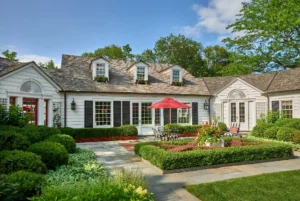
Investing in landscape design offers numerous benefits. It increases property value, enhances curb appeal, and provides a peaceful retreat. A well-designed landscape also promotes environmental sustainability by incorporating native plants and efficient irrigation systems.
Increasing Property Value with Enhanced Curb Appeal
A thoughtfully designed landscape significantly boosts the value of your property. Potential buyers are often drawn to homes with beautiful, functional outdoor spaces. Curb appeal is the first impression your home makes on visitors or potential buyers. A stunning front yard design creates an inviting atmosphere and showcases the care and attention given to the property.
Creating a Personal Retreat
Your landscape can be a sanctuary from the stresses of everyday life. A well-designed outdoor space provides a peaceful retreat for relaxation, recreation, and connection with nature. Whether you enjoy gardening, dining al fresco, or simply lounging with a good book, your landscape should be a personal oasis.
Promoting Environmental Sustainability
Sustainable landscape practices benefit both your garden and the environment. By choosing native plants and efficient irrigation systems, you conserve water and support local ecosystems. This can contribute to a healthier environment for future generations.
Design with Purpose
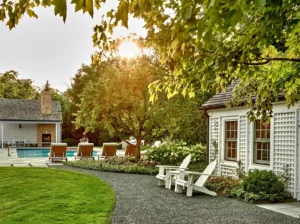
Designing your dream landscape is more than a project—it’s a personal journey filled with creativity, discovery, and connection. Whether starting fresh or reimagining an existing space, thoughtful planning, and expert guidance can help you create something truly special. It’s not just about beauty; it’s about building a space that enhances your lifestyle, brings daily joy, and grows with you over time.
Envision What’s Possible
As you look ahead, imagine a landscape that’s not only visually stunning but also deeply personal. Whether you’re dreaming of a family-friendly garden, a serene retreat, or an entertainer’s paradise, the principles in this guide will help you build a space that feels like home. Embrace the possibilities and start designing a life lived beautifully—outdoors.
At Mariani Landscape, we believe your landscape should be a reflection of you—your lifestyle, your personality, and your aspirations. Whether you crave a private getaway to unwind or an open-air space to host unforgettable moments, the design must align with your unique vision. We don’t design our landscape—we design yours. Every decision is shaped by your goals and rooted in your space. We begin by listening. Understanding what matters most to you allows us to design with intention and clarity. Through close collaboration, detailed planning, and an inquisitive approach, we ensure that each element serves a purpose and supports the way you want to live outdoors. From thoughtful site planning to expert craftsmanship and seamless communication, we guide every step of your journey.
Bringing Your Dream to Life
With over 65 years of experience and a legacy of excellence, our team at Mariani Landscape offers more than design—we deliver transformation. Your outdoor space becomes a living extension of your home, crafted with care and designed to endure. Now is the time to bring that vision to life.
Request a consulation to begin designing the landscape of your dreams with our team of industry-leading landscape architects. Live your best life outdoors and let Mariani Landscape transform your property into a place that’s truly, beautifully yours.





